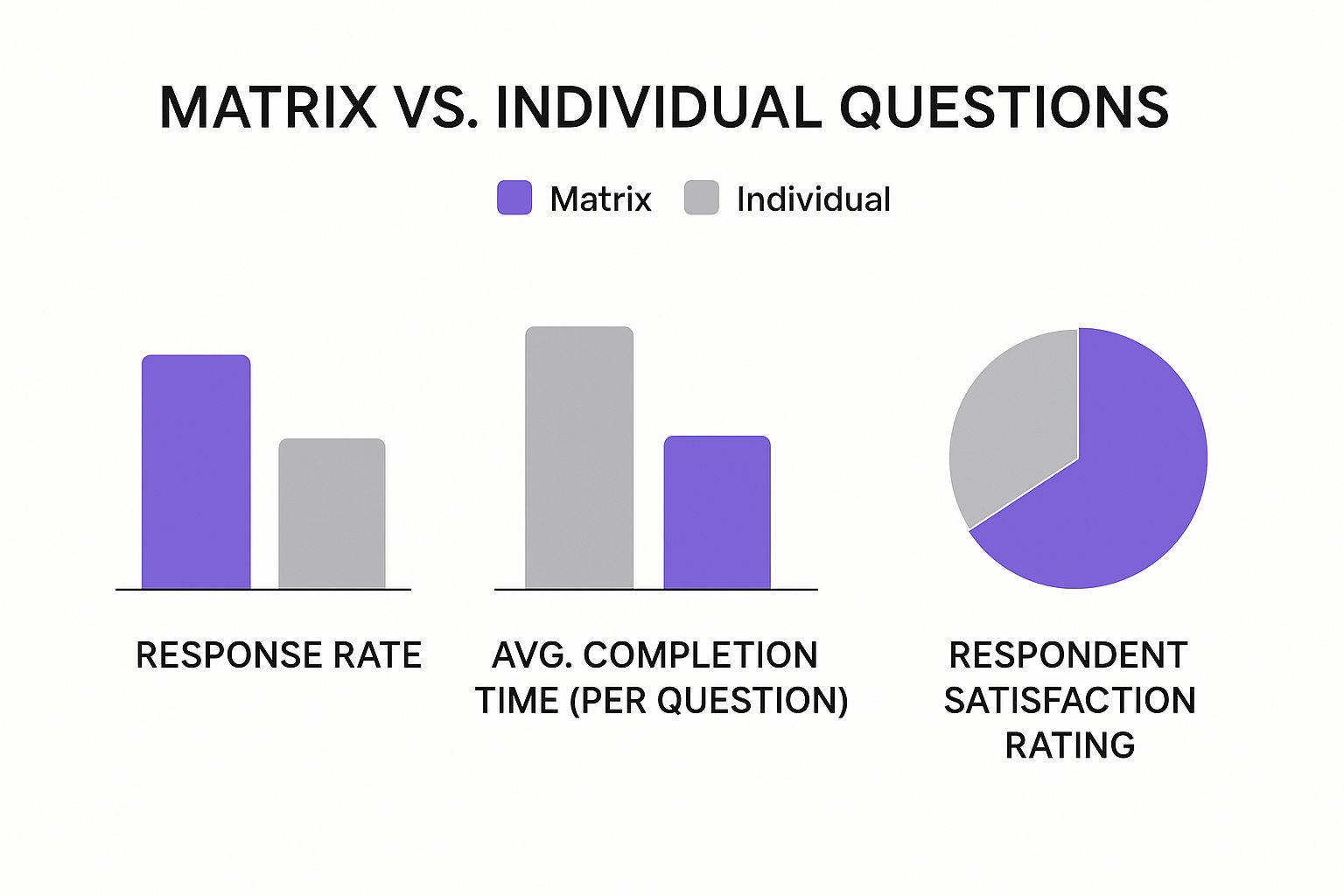Mastering Matrix Questions in Surveys
Cre cleaner data and higher response rates. This guide covers how to use matrix questions in surveys, from design best practices to avoiding common pitfalls.te

Ever tried to understand customer satisfaction by just throwing a bunch of separate questions at someone? It feels disorganized and, frankly, a bit overwhelming. That's where matrix questions come in. They offer a much cleaner, more streamlined way to get the answers you need.
By grouping similar questions into a single table with a shared answer scale, this format makes the whole survey experience better. It cuts down on respondent fatigue and saves a ton of time for both you and the person filling it out.
What Are Matrix Questions and Why Do They Matter?

At its core, a matrix question is a closed-ended question type that neatly organizes multiple sub-questions into a grid. You have your individual items or questions in the rows, and a consistent set of answer choices, like a Likert scale, in the columns.
This structure transforms what could be a long, repetitive series of individual questions into one compact block. Instead of asking "How satisfied are you with our customer support?" and then immediately following with "How satisfied are you with our product's ease of use?", you can bundle them. This simple change makes the survey feel shorter and far more intuitive.
The Core Components of a Matrix Question
Getting a handle on the anatomy of matrix questions in surveys is pretty straightforward. Think of it like a small spreadsheet embedded right inside your form.
Here are the key elements:
- Row Items: These are the specific statements or ideas you want people to evaluate. Each row represents a distinct item.
- Column Choices: These are the predefined answer options that apply to every single row. This is usually a rating scale, like "Strongly Disagree" to "Strongly Agree."
- The Grid: This is the visual table that brings it all together, letting respondents click through their answers efficiently.
This simple structure is the secret to its efficiency. It lets you gather a ton of related data without making your users feel like they're slogging through a test.
Why This Format Is a Game-Changer
The real magic of matrix questions is how they boost both data quality and the user experience at the same time. Think about it: a standard survey with 15 separate Likert-scale questions can impose up to 30% more cognitive load on someone compared to a matrix format. That's a lot of extra mental work.
By grouping related items, you're not just making things look tidier; you're making it easier for people to think and respond.
A global tech company saw a 20% jump in survey completion rates after they switched to matrix-based satisfaction surveys. Their average response times also dropped from 5.5 to 4.2 minutes per user. This shows a direct link between smart question design and keeping people engaged.
Ultimately, this kind of efficiency is a huge win for any business. Knowing how to approach collecting customer feedback effectively is what drives growth, and matrix questions are a fundamental part of that toolkit. They give you standardized, easily comparable data that simplifies your analysis and helps you pull out meaningful insights much faster. For any serious researcher or product team, they're simply indispensable.
Choosing The Right Type Of Matrix Question
Picking the right tool for the job is always crucial, and the same goes for survey design. Not all matrix questions in surveys are the same; each one is built for a specific purpose. Getting this choice right is the difference between collecting clear, actionable data and ending up with a jumble of ambiguous results that are a headache to interpret.
Your research goal should be your north star. Are you trying to get a single, clear-cut rating for several items? Or do you need to know all the options that apply to each one? The answer will lead you straight to the perfect matrix format for your needs.
Single-Choice Grids For Exclusive Answers
The most common format you'll see is the single-choice matrix, which uses radio buttons. Think of it as a "one answer per row" rule. It pushes the respondent to make a single, decisive selection from the scale for each item you present.
This format is perfect for situations where the answers are mutually exclusive. For instance, you can't be "Very Satisfied" and "Very Dissatisfied" with a product feature at the exact same time.
Here are some classic use cases for single-choice matrices:
- Satisfaction Ratings: Asking customers to rate how satisfied they are with different parts of your service, like speed, quality, or price.
- Agreement Scales: Seeing how strongly people agree or disagree with a series of statements about a policy or your brand.
- Frequency Questions: Figuring out how often a user does certain things, such as daily, weekly, or monthly.
By forcing a single choice, this matrix type gives you clean data that’s a breeze to analyze. It cuts out the ambiguity and gives a clear signal on how each individual item stacks up against a consistent scale.
Multi-Select Grids For Multiple Answers
But what if you need people to pick all the options that apply from a list of items? That’s where the multi-select matrix shines. Instead of radio buttons, this format uses checkboxes, letting respondents make multiple selections in each row.
This type is ideal for questions where multiple answers aren't just possible, they're expected. For example, if you're asking a team which software they use for different jobs, they might use several tools for a single task like "Project Management."
You'll want to use a multi-select matrix when you need to know things like:
- Which features a customer uses across your different products.
- Which communication channels an employee checks for various internal updates.
- Which symptoms a patient is experiencing for different medical conditions.
This infographic shows a side-by-side comparison of how matrix questions perform against individual ones.

The data speaks for itself. Matrix formats don't just make respondents happier; they also slash the time it takes to answer each question.
A Quick Comparison Of Matrix Question Types
To help you decide which format is best for your specific needs, here’s a quick breakdown of the most common matrix question types and where they shine.
Matrix TypeDescriptionBest Used ForExample ScenarioSingle-ChoiceUses radio buttons, allowing only one selection per row.Situations where answers are mutually exclusive, like rating scales.Rating satisfaction with different aspects of a hotel stay (e.g., Cleanliness, Staff Friendliness).Multi-SelectUses checkboxes, allowing multiple selections per row.Questions where multiple answers can apply to each item.Asking which social media platforms employees use for different work tasks (e.g., Marketing, HR).Text-EntryProvides a text field for each row, allowing open-ended input.Gathering concise, structured qualitative feedback for multiple items.Asking a manager to write a one-sentence performance goal for each team member.
Choosing the right type from this table will ensure your data is not only easy to collect but also highly relevant to your research goals.
Specialized Matrix Formats
Beyond the basics, other specialized formats can deliver even richer insights. One powerful variation is the text-entry matrix. This grid gives you the organized structure of a matrix but with the flexibility of open-ended feedback by including a text box for each row.
Imagine asking a manager to provide a one-sentence performance goal for each person on their team. A text-entry matrix keeps the feedback tidy and directly tied to each individual, which makes the data far easier to manage than a bunch of disconnected open-text fields. It’s an excellent way to gather focused, qualitative feedback in a structured format.
Ultimately, understanding the different types of survey questions and what they’re good at is fundamental to effective research. By moving beyond a one-size-fits-all approach and carefully picking the right matrix question for your goal, you make sure the data you collect is both accurate and genuinely insightful.
The Strategic Benefits of Using Matrix Questions

Sure, the most obvious perk of a matrix question is that it saves a ton of screen space. But that's just scratching the surface. The real magic happens behind the scenes, where these grids act less like a space-saver and more like a powerful engine for data quality.
Think about it. The organized grid format doesn't just look clean; it forces a kind of standardized thinking that produces a dataset ready for immediate analysis. When every single person evaluates different items, like your product features or service standards, the exact same scale, your ability to compare apples to apples becomes incredibly strong.
You can effortlessly spot trends over time or slice your data by different customer groups, all without worrying if the results are skewed by weird question phrasing. This leads directly to cleaner, more reliable insights.
Boosting Data Quality And Consistency
One of the biggest wins here is a huge improvement in data integrity. The structured layout of a matrix question subtly guides the respondent, nudging them to consider each item in a systematic way. This simple design trick dramatically reduces the odds of someone accidentally skipping a question, which is a common headache with long, scrolling lists of individual questions.
This guided process also encourages more thoughtful and consistent answers across related items. A cross-industry analysis confirmed that matrix questions slashed respondent error rates, like accidentally missing an item, by up to 17% compared to traditional formats. Even better, the data pulled from these surveys had up to 40% fewer missing values, which is a massive win for any analyst.
That cleaner data means your team spends far less time scrubbing and preparing it, and more time finding the story within it.
Faster Time To Insight And Action
Because the data from matrix questions is so standardized, it’s not just cleaner, it's also much faster to analyze. When you export the responses, they land in a beautiful, table-like format that’s practically begging to be dropped into Excel or Google Sheets. No more spending hours trying to wrangle and reorganize data from dozens of separate questions.
This efficiency isn't just a nice-to-have; it's a real competitive edge. Analysts have reported that this organized structure allows them to build out satisfaction dashboards and reports weeks faster than when they’re stuck with data from disjointed, individual questions.
This speed means your team can move from data collection to actionable insights in record time. For any business focused on understanding key customer experience KPIs, matrix questions provide a direct path to the insights you need to measure and improve performance. This agility allows you to react to customer feedback, fix problems, and jump on opportunities almost as they happen.
Improving The Respondent Experience
Finally, let’s not forget the person on the other side of the screen. A well-designed matrix question respects the respondent's time and energy. Instead of hitting them with a seemingly endless wall of repetitive questions, you’re giving them a compact, easy-to-scan grid. This drastically cuts down on cognitive load and survey fatigue.
This improved experience pays off in a big way:
- Higher Completion Rates: When a survey feels shorter and more organized, people are far more likely to see it through to the end. One major retailer saw completion rates jump to 92% with matrix-based surveys, a huge leap from the 76% they got with their older, longer formats.
- More Consistent Answers: The layout encourages people to be more thoughtful, as they can easily compare their ratings across similar items.
- Reduced "Straightlining": While always a risk in poorly designed surveys, a concise and well-structured grid can actually reduce random clicking by keeping respondents engaged.
Ultimately, using matrix questions in surveys is a strategic move that delivers benefits across the board. It leads to higher-quality data, a more efficient analysis workflow, and a much better experience for the very people whose feedback you rely on.
Common Mistakes That Can Ruin Your Survey Data
While matrix questions in surveys are fantastic for efficiency, a poorly designed grid can do more harm than good. Instead of giving you clean, comparable data, it can inject noise, frustration, and skewed results that lead your decisions down the wrong path.
The biggest villain here is a little something we call "matrix fatigue."
This is what happens when someone opens your survey and is hit with a massive wall of questions. Their eyes glaze over, their focus dissolves, and they start looking for shortcuts just to get to the end. This leads to two huge data quality problems:
- Straightlining: This is when a respondent just clicks the same answer for every single row, think "Neutral" all the way down, without actually reading the items.
- Random Responding: This is when they start clicking answers without any real thought, creating chaotic data that’s completely meaningless.
Both of these behaviors poison your dataset and make the feedback worthless. The trick to avoiding this is to respect your respondent's time and keep your matrices focused and concise.
The Overwhelming Grid
The most common mistake, by far, is trying to cram too many items into a single matrix. It might feel efficient when you're building the survey, but it's a total disaster for the person taking it, and for your data. Research has shown a direct link between the size of a matrix and the quality of the answers.
As great as they are, using too many matrix questions can seriously hurt your response quality. Studies have found that the sweet spot for rows is somewhere between 5 and 10. Once the grid gets bigger, the data starts to suffer. One analysis found that completion rates dropped from 88% for a 5-item matrix to just 62% for a 20-item one.
Worse yet, data errors like straightlining shot up from 7% to 22% in that same range. This problem gets even bigger on smaller screens, which brings us to the next critical mistake.
Ignoring The Mobile Experience
Let's face it: a huge chunk of your audience will take your survey on a smartphone. A wide, sprawling matrix that looks perfectly fine on a desktop monitor becomes an absolute nightmare on a mobile device. It forces people into that awkward horizontal scrolling dance, which is a universally hated experience.
This isn't just a minor annoyance; it actively damages your data. Mobile users who run into these clunky matrices are far more likely to just give up and abandon the survey altogether. This can crater your ability to improve your overall survey response rate.
A study highlighted this exact problem, noting that mobile users reported 18% lower satisfaction with surveys when matrices went beyond 12 rows. That frustration comes directly from all the scrolling and the mental effort it takes just to navigate the question.
To sidestep this, always design with a mobile-first mindset. Keep your matrices narrow (ideally 5 columns or fewer) and don't be afraid to break up longer lists into several smaller, more manageable grids.
Vague Labels And Inconsistent Statements
The final pitfall is all about the words you choose. The clarity of your row statements and column labels is everything. If someone has to re-read a statement or can't tell the difference between "Somewhat Agree" and "Slightly Agree," you've created confusion.
Stick to these simple rules for clear, effective writing:
- Keep Row Statements Short: Each item should be a quick, easy-to-digest statement.
- Maintain Parallel Structure: Start each statement in a similar way (e.g., using the same verb tense). This makes the list much easier to scan.
- Use Clear Column Labels: Your scale points should be logical, distinct, and instantly understandable. Steer clear of jargon or ambiguous terms.
Even with a perfect design, survey data isn't always flawless. Knowing some essential data cleaning techniques can help you rescue and sharpen your insights. By dodging these common mistakes, you can make sure your matrix questions gather the accurate, high-quality data you need.
Best Practices for Effective Matrix Question Design
Crafting a good matrix question is a bit of an art and a science. When you nail it, you get clean, easy-to-compare data. But when you get it wrong, you end up with confused respondents and results you can't trust.
Let's walk through some best practices that I've seen work time and time again. These will help you build matrix questions that are not only powerful for your analysis but also painless for the people taking your survey.
The absolute foundation of a great matrix question is clarity. Every single part of it, from the statements in each row to the labels on your columns, has to be instantly understandable. Your goal is to squash any chance of misinterpretation so that every participant sees the question the same way.
Keep Row Statements Concise and Consistent
The statements in your rows are the heart of the question. To make them a breeze for people to scan and answer, you need to keep them short, direct, and written in a parallel structure.
- Be Brief: Long, complicated statements are a recipe for confusion and survey fatigue. Each row should focus on a single, clear idea that someone can read and grasp in a few seconds.
- Maintain a Parallel Structure: Try to start each statement in a similar way. For instance, if you're getting feedback on a product, each row could begin with "The product's..." (like "...ease of use," "...reliability," or "...design"). This rhythm helps people get into a flow, making the whole process quicker and less of a mental chore.
Think of your row items like a simple checklist. A good one is quick to scan and easy to process, and that's exactly the vibe you're going for here. This approach seriously cuts down on the risk of respondents getting tired and just clicking down the same column, what we call straightlining.
Design Clear and Logical Column Labels
Your column labels are the scale. They define how respondents will rate each item, so they need to be crystal clear, logical, and cover the whole range of possible feelings without any weird overlaps.
The labels on your scale act as the signposts for your data. If the signposts are confusing, your respondents will get lost, and the data they provide will be untrustworthy.
A well-designed scale just feels intuitive. A classic five-point scale from "Very Dissatisfied" to "Very Satisfied" is something pretty much everyone gets. If you want to dive deeper into crafting solid scales, it's worth checking out some Likert scale examples for surveys, as they're a common and effective base for matrix columns. Whatever you do, steer clear of jargon or vague words that could mean different things to different people.
Enhance Readability with Visual Design
Don't underestimate the power of visual design. How your matrix question looks plays a huge role in how people interact with it. A cluttered, messy grid can feel intimidating and lead to mistakes. Luckily, a few simple design tweaks can make a world of difference.
One of the most effective tricks is using zebra striping, which is just a fancy term for alternating the background color of your rows. This simple visual cue helps guide the eye across the grid, making it way easier to match the right row with the intended answer. It’s a lifesaver in larger matrices where it's easy to accidentally click the wrong radio button.
Another key is white space. Don't try to cram everything together. Giving your rows and columns a little room to breathe makes the whole grid feel less dense and more approachable. This small touch goes a long way in making the experience smoother for your respondents.
Real-World Examples of Matrix Questions in Action

Theory and best practices are great, but seeing a concept in the wild is where it really clicks. The true power of matrix questions in surveys comes alive when you see how they solve actual business problems across different industries. Let’s walk through a few concrete examples.
These scenarios show just how a matrix format can pull in clear, comparable data that would be clunky and frankly, a pain to gather with a long string of individual questions. It's a real workhorse for gathering insights, from customer feedback to employee engagement.
Customer Satisfaction in a SaaS Company
Imagine a SaaS platform like ours, Surva.ai, trying to figure out how users really feel about its core features. Asking a separate question for every single feature would create a ridiculously long and repetitive survey. Most users would probably give up halfway through.
This is where a single-choice matrix question is the perfect fix.
Here’s what it could look like:
- Question: Please rate your satisfaction with the following aspects of our platform.
- Dashboard ease of use
- Survey builder flexibility
- AI-powered insights
- Integration with Slack
- Customer support response time
This simple grid lets the product team see at a glance which features are hitting the mark and which ones are falling flat. If "AI-powered insights" consistently gets lower scores than everything else, that's a bright red flag telling them to dig deeper and prioritize improvements.
Employee Engagement at a Growing Tech Firm
Now, let's shift gears to an HR department trying to get a pulse on employee morale and cultural fit. They need to understand how staff feel about multiple parts of the job, from management to career opportunities. A matrix question using an agreement scale is the ideal tool for the job.
A well-structured engagement survey helps leadership pinpoint specific areas of discontent before they become widespread problems. Using a matrix ensures the feedback is standardized and easy to track over time.
For instance:
- Question: To what extent do you agree with the following statements about our workplace?
- I feel my contributions are valued.
- My manager provides clear and actionable feedback.
- I see clear opportunities for career growth here.
- The leadership team communicates a clear vision for the future.
The results from this matrix might show that while people feel valued, they're not confident about their career growth. That specific insight allows the company to focus on building clearer career paths, a much more targeted action than a vague goal to "improve morale." By running this survey quarterly, they can track the direct impact of their changes.
Market Research for a New Product Launch
Finally, picture a consumer brand getting ready to launch a new line of snacks. Before they pour millions into production, they need to know if people would actually buy them. A matrix question can efficiently test how people feel about several potential products all at once.
The setup is pretty straightforward:
- Question: Based on the description, how likely would you be to purchase each of the following new snack flavors?
- Spicy Thai Chili Almonds
- Honey Balsamic Cashews
- Smoked Paprika & Lime Peanuts
This quick, scannable format gives the brand a clear ranking of which ideas resonate most with their audience. It helps them make a smart, data-backed decision on which flavor to move forward with.
Got Questions About Matrix Questions? We've Got Answers.
You've made it this far, which means you're almost ready to start building smarter surveys. But you might still have a few lingering questions. That's perfectly normal.
This section is designed to tackle the most common "what ifs" and "how tos" we hear about matrix questions. Think of it as a quick-reference guide to clear up any final doubts so you can use them with confidence.
When Should I Steer Clear of a Matrix Question?
Matrix questions are powerful, but they’re not a one-size-fits-all solution. You should absolutely avoid them when your sub-questions aren't closely related or don't share the exact same answer scale.
Forcing unrelated items together, like asking about product features and customer support in the same grid, just creates confusion. It’s a recipe for muddled, low-quality data.
Also, if you're fishing for detailed, nuanced feedback on each item, a matrix won't cut it. In that case, individual open-ended questions are a much better bet. And for super long lists (think more than 10 items), it's best to split them into a few smaller matrix questions or just use a different format. This simple step keeps people from feeling overwhelmed and helps maintain the quality of their answers.
How Do I Make Matrix Questions Work on Mobile?
This is a big one. To make sure your matrix questions in surveys don't become a thumb-cramping nightmare on mobile, the trick is to keep them short and narrow. The goal is to get rid of horizontal scrolling entirely.
Here's how:
- Limit Columns: Stick to 5 or fewer answer choices if you can.
- Limit Rows: Keep your list of items to 7 or fewer for the best experience.
Good news! Many modern survey tools, like Surva.ai, are smart enough to automatically reformat a wide matrix into a more user-friendly, one-question-at-a-time view on mobile devices. If your platform doesn't do this, you can always improve the experience by manually breaking a large matrix into two smaller ones.
What Is Straightlining and How Do I Stop It?
Ever seen a survey response where someone clicks the same answer for every single row? That's straightlining. It usually happens when someone gets bored or just wants to speed through the survey, and it's a huge red flag for disengagement that can seriously mess with your results.
First and foremost, keep your matrix questions concise, research suggests that 5 to 10 rows is the sweet spot. You can also get clever and introduce a few reverse-worded items (like, "The process was confusing") among a series of otherwise positive statements. This little trick encourages people to read more carefully.
Finally, make sure your row items are genuinely relevant and consider randomizing their order for each person. This helps break up the monotony and makes it harder for respondents to fall into that mindless clicking pattern.
Ready to build user-friendly matrix questions that deliver crystal-clear insights? Surva.ai gives you all the tools you need to create effective surveys, fight respondent fatigue, and turn solid feedback into real growth. Explore our AI-powered platform and start building smarter surveys today.


